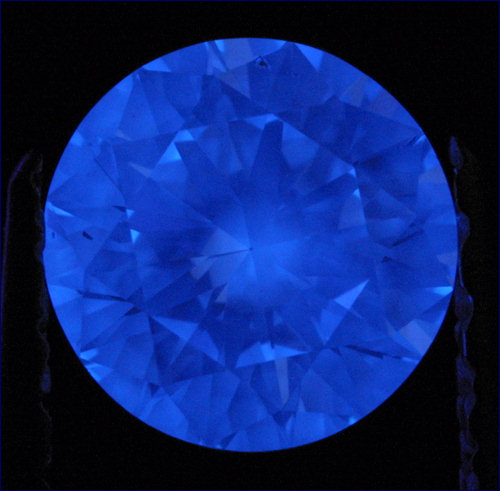|
When examining diamonds with a UV lamp, diagnostic features are the color, intensity, and distribution of fluorescence and phosphorescence. For the latter, the decay time is also important. This examination method can be applied only after determining the color characteristics of the sample under study.
To perform the fluorescence/phosphorescence test, a UV lamp with radiation wavelengths of 365 and 254 nm is required. It is recommended to run the test in a dark room or after screening foreign illumination sources (this is especially important when studying phosphorescence).
Fluorescence and phosphorescence of natural and synthetic diamonds can be classified according to the color group which the studied diamond belongs to:
- fluorescence and phosphorescence of yellow diamonds;
- fluorescence and phosphorescence of colorless (or almost colorless) diamonds;
- fluorescence and phosphorescence of blue and cyan diamonds.
 Fluorescence and phosphorescence of yellow diamonds
Fluorescence and phosphorescence of yellow diamonds |
- Both natural and synthetic yellow diamonds show fluorescence when exposed to S.W. or L.W. UV light. The absence of fluorescence is not a diagnostic feature.
- The presence of blue fluorescence of various intensity (for both S.W. and L.W. UV irradiation) or orange fluorescence with narrow curved green zones unambiguously testifies to the natural origin of the diamond under study. For synthetic diamonds, yellowish green fluorescence is typical for both S.W. and L.W. UV irradiation (such fluorescence can sometimes occur in natural samples).
| Blue long- wave U.V. fluorescence in a natural polished diamond
|
|
 |
- A distinctive feature of natural diamonds is a uniform distribution of fluorescence (a non-uniform distribution occurs very rarely), while synthetics are characterized by a non-uniform distribution of fluorescence, which follows internal growth sectors, forming square, octagonal, and cross-like patterns. The presence of fluorescence looking like stripes parallel to graining planes inside the growth sectors is also a feature of the synthetic origin of the stone under study.
- Synthetic diamonds typically show long (30-60 s) yellow phosphorescence (for both S.W. and L.W. UV irradiation) or, sometimes, weak green phosphorescence. Moderate yellow phosphorescence (for both S.W. and L.W. UV irradiation) with a decay time of no more than 15 s can be considered as a feature of the natural origin of the studied diamond. Weak yellow phosphorescence is peculiar to both natural and synthetic samples. The absence of phosphorescence is not a diagnostic feature.
|
 Fluorescence and phosphorescence of colorless and almost colorless diamonds
Fluorescence and phosphorescence of colorless and almost colorless diamonds |
- Colorless and almost colorless diamonds rarely show S.W. and L.W. fluorescence. However, the presence of yellow or orange fluorescence (S.W. and L.W.) testifies to the natural origin of the stone under study, while greenish yellow S.W. fluorescence, in the case of the absence of L.W. fluorescence, is a feature of the synthetic origin of the diamond.
- Natural diamonds are characterized by more intense L.W. fluorescence, while more intense S.W. fluorescence is typical of synthetics.
- A distinctive feature of natural diamonds is a uniform distribution of fluorescence (a non-uniform distribution occurs very rarely), while synthetics are characterized by a non-uniform distribution of fluorescence, which follows internal growth sectors, forming square, octagonal, and cross-like patterns. The presence of fluorescence looking like stripes parallel to graining planes inside the growth sectors is also a feature of the synthetic origin of the stone under study.
- Weak yellow phosphorescence with a decay time not exceeding 30 s is a feature of natural diamonds. Synthetic diamonds typically show white, blue, yellow, or greenish yellow S.W. phosphorescence, which lasts for 60 s and longer. The intensity of this phosphorescence ranges from moderate to strong. The absence of phosphorescence is a feature of natural diamonds.
|
 Fluorescence and phosphorescence of blue and cyan diamonds
Fluorescence and phosphorescence of blue and cyan diamonds |
- Orange or orange-red S.W. and L.W fluorescence is a distinctive feature of natural diamonds, while synthetics typically show yellowish green S.W. fluorescence in the absence of L.W. fluorescence.
- In most cases, the intensity of fluorescence is not a diagnostic feature. However, the presence of more intense L.W. fluorescence is more typical to natural diamonds.
- A distinctive feature of natural diamonds is a uniform distribution of fluorescence (a non-uniform distribution occurs very rarely), while synthetics are characterized by a non-uniform distribution of fluorescence, which follows internal growth sectors, forming square, octagonal, and cross-like patterns. The presence of fluorescence looking like stripes parallel to graining planes inside the growth sectors is also a feature of the synthetic origin of the stone under study.
- Bluish white (rarely - orange or orange-red) S.W. and L.W. phosphorescence is a distinctive feature of natural diamonds. For synthetics, a distinctive feature is intense yellow S.W. phosphorescence, while weak yellow phosphorescence is a feature of natural stones. As a rule, synthetics are characterized by long phosphorescence (30-60 s), while in natural diamonds phosphorescence decays faster (the decay time does not exceed 15 s).
Recommended procedure for studying fluorescence and phosphorescence upon UV irradiation:
- CAUTION: Avoid shining the radiation of a UV lamp directly into your eyes!
- Carefully clean the studied sample before starting the test.
- Perform the fluorescence/phosphorescence test using a UV lamp.
- Analyze the observed features using the description of fluorescence and phosphorescence of natural and synthetic diamonds.
|
|
